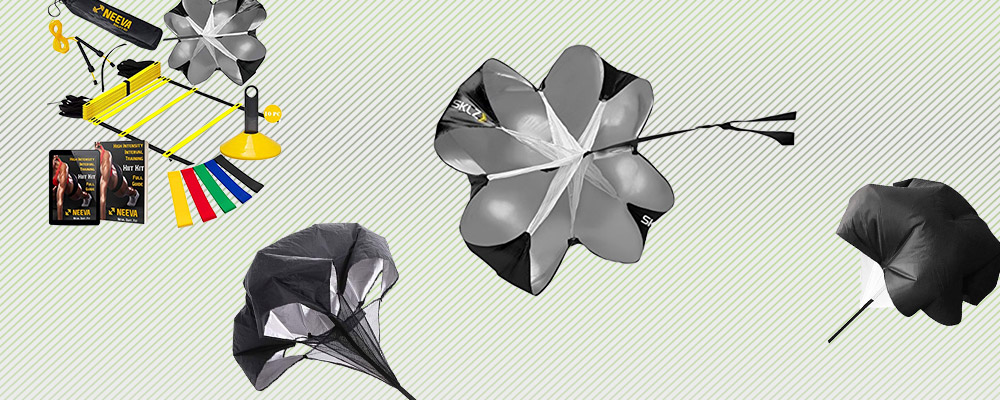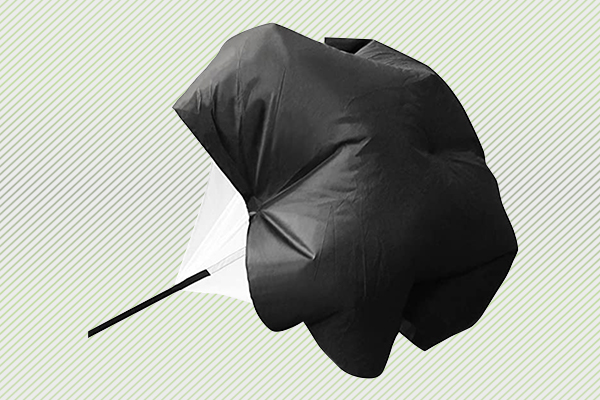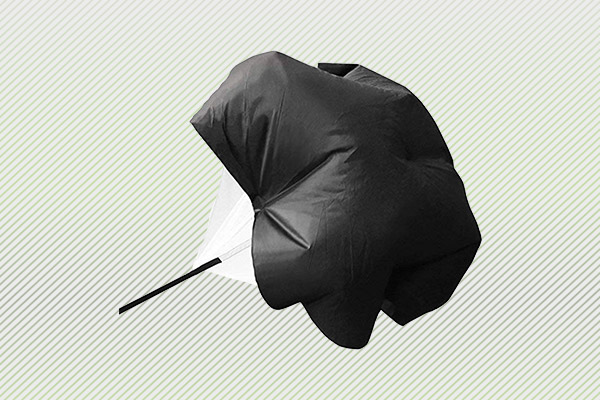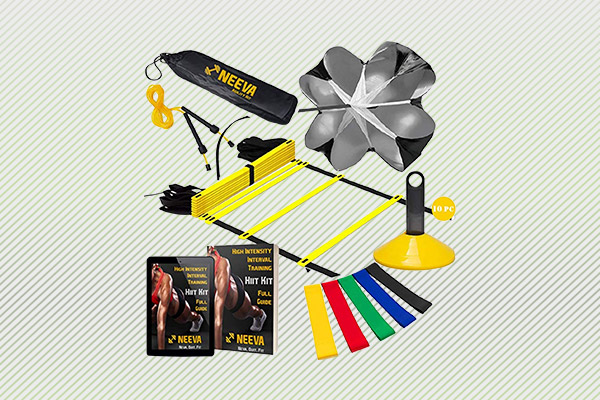Speed chutes are cloth canopies that attach to a belt or harness on an athlete. When the athlete runs, the speed chute will function similar to a kite or a parachute, filling with air and increasing the resistance to run in the intended direction. Speed chutes aim to improve acceleration, transition, and top-speeds by adding a backward drag of varying levels of resistance when running.
Speed chutes differentiate by the equipment that accompanies the actual chute itself, the resistance the chute adds, and the material it’s made from. So let’s get on the right track and find the best speed chute for you.

Editor’s Pick

Great for multi-directional training.
Pros:
- The harness can fit athletes up to a 42 inch waist.
- Built-in mesh panels help prevent tangling.
- Seven connection points to the harness can provide better stability during training.
Cons:
- May not function as designed during non-sprint training.
- Movement around the belt can increase the difficulty to get it aloft.
- Might not be suitable for beginners.

This parachute is made from dense parachute cloth and measures 56 inches while providing 25-35lb of resistance. The velcro waist harness is designed with a 360 degree rotational ring to allow multi-directional movement during training.
Contender

Easy release for fast sprinters.
Pros:
- Velcro waist harness can make for easier removal mid-sprint.
- Carrying bag included can provide easier portability.
- On the more affordable end of the market.
Cons:
- May not be suitable for use in inclement weather.
- Durability may not be as strong as several competitors.
- Can incur tears if released while running on rough terrain.

This parachute has a 56 inch diameter with the capacity to provide 25-35lb worth of resistance. Multiple parachutes can be stacked to increase the resistance level as desired. The waist harness utilizes a velcro attachment.
Also Consider

Heavy resistance with a quick release.
Pros:
- The quick release belt buckle enables higher diversity of training exercises.
- Includes a training bag.
- Many customers said this chute worked well for kids.
Cons:
- The waist strap may cause you to change your running mechanics to a more upright position activate the chute.
- The price is a tad higher than comparable options.

This parachute comes with a 360 degree adjustable 2 inch nylon rotation belt to ensure more freedom of movement. The quick release belt buckle makes this chute stand out from other options. The buckle is detachable mid-exercise, allowing for a higher variety of acceleration training. The chute adds up to 30lbs of resistance and is stabilized by built-in mesh panels that also help prevent the chute from tangling.
Also Consider

Lightweight with scalable resistance.
Pros:
- Waist harness fits up to 42 inch waists, so it may be more comfortable for larger athletes.
- Useful for teaching proper running mechanics.
- More affordable than comparable options.
Cons:
- Several customers mentioned the waist harness being too large for younger kids.

This parachute provides up to 30lbs of resistance and includes a travel bag. It’s made of polyester and at just under half a pound, it’s fairly lightweight compared to most competitors. The waist harness is designed to support multiple speed chutes should the desire to further up the resistance arise.
Best Bundle

The package deal.
Pros:
- The additional equipment can enable a larger variety of skills than just the speed chute alone.
- Great for sports teams or larger families.
- Carry bag can make traveling with all the equipment more feasible.
Cons:
- On the pricier end of the market.

This training kit is going to put more pressure on your wallet than purchasing the speed chute individually, but the bang for your buck may be worthwhile. This bundle includes the aforementioned speed chute and harness, ten flexible agility cones and carrying caddy, an agility ladder with four metal stakes, four resistance bands, a jump rope, an e-book training guide, and a carrying bag.
Methodology
Resistance:
The resistance on speed chutes will always come in a range because it has to account for how fast the runner harnessed to it is moving. Most speed chutes fall somewhere in the range of 15 to 30lbs of resistance, with a minority going up to 33 or 35lbs. Some chutes are equipped with a harness that is capable of supporting more than one speed chute simultaneously. If you are an athlete that is looking for a higher resistance, seeking out the speed chutes designed to function alongside another chute is likely to your benefit.
Material:
Many speed chutes are going to be made of polyester and have mesh or something similar holding the chute to the waist harness to prevent tangling. Some chutes, however, will be more resistant to water or have a sunshield to function better in intense heat. Depending on the type of training you intend to do, a chute with these kinds of additions could prove to be best for you.
Harness Style and Utility:
The biggest factor to look for in the harness is whether or not it has a quick-release function or a detachable buckle. Not every harness will have it, but it can enable a variety of training where the chute adds resistance during acceleration and then release during transition to allow for top-speeds. The majority of chutes will have waist harnesses, but there are athletes that would prefer a shoulder harness when training with a speed chute. If that is your preference, check if the chute you’re considering has a shoulder harness option or would be compatible with one. Be conscious that the shoulder harness doesn’t restrict your arm movement when running.
Wrapping Up
A speed chute will try to slow you down in practice so you can speed up in performance. Whether an individual or a team for the track or the field, a speed chute is a valuable piece of equipment many athletes’ training programs.